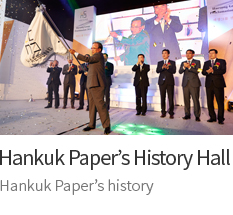
For inquiries, click on the following questions to see the answers in detail.
-
- What are the raw materials needed for Paper manufacturing?
Paper is made with 1% of raw material and 99% of water. The raw materials of paper can be divided into a main material pulp (Fiber) and sub materials (non Fiber material). Depending on the 1% of material formulation, the various types of paper can be made.
For more information on the raw materials needed for paper manufacturing can be found on the Korea Paper Association Website.
-
- I would like to know the manufacturing process of the paper.
There are 4 stages in manufacturing a paper.
① Building process: Preparation of making paper
② Paper mill process : making paper with the prepared materials.
③ Coating process : Coating the chemicals on to the paper.
④ Completing process : packing the completed paper according to the customer’s requirements.
For more information on the four manufacturing processes can be found from the Product Information > Manufacture Process.
-
- Is there a Texture on a paper?
Yes, there is texture on papers as well.
The reason why texture is formed on a paper is due to the characteristics of the paper making process. Wood fiber, the raw material of paper, is mostly long and thin fibers.
The textures are made to the direction of the fiber movement.
When the paper is first made, the texture is same in a scroll, but depending on what direction you are cutting, the cross direction texture and Machine Direction texture are made.
• How to see the Paper texture
There are many ways to sort paper texture, such as tearing, turning, wetting with water, reflection on the light, and so on but it is not so easy.
The simplest way to know for sure, is by checking the ‘label’ in the packaging of the paper.
-
- What is the specification of Paper?
Paper specification is essential for the design and production of paper-based publications and promotional materials. The paper specifications used generally, is available on the Korea Paper Association homepage.
-
- What are the types of Paper?
- The types of papers could be divided into newspaper, printing paper, specialty paper, hygiene paper and packaging paper. The Characteristic of each types of paper can be checked through Korea Paper Association Homepage.
-
- Origin of Paper
• Origin of Paper
The origin of paper is Papyrus of ancient Egypt. However, the concept and the origin of paper are different. Papyrus uses a very different method to paper which uses the peeling of the papyrus plant itself and then thinning the inner core and sticking it in a plate form, but because papyrus was used as a paper, English speaking countries have decided papyrus as the origin of paper and started to call it a ‘paper’, ‘paiper’ in French, ‘papel’ in Spanish and ‘papper’ in Swedish.
• Origin of Paper
The term condition of “Paper” are as follows.
First, the shape is thin and flat,
Second, it is a plant fiber which unpacks the raw materials one by one.
Third, it has a net structure, which is an intertwined structure of fibers.
Fourth, the fibers are dispersed in water and then sieved with a net for water filtration.
The above four conditions are how it was invented by ChaeRyun in AD 105. The inventor of paper is a person from the Chinese prehistoric age called ChaeRyun. In the HuHan ChaeRyun book, it is said that, “ChaeRyun has made paper with the inner part of a tree trunk, flax fiber, fish net and a rag cloth to give to the emperor in the first year of the reign (AD 105). Of course, paper was already invented in a primitive form using hemp and rags before ChaeRyun, and has gradually improved.
However, given the fact that ChaeRyun has recognized the importance of paper who was a government officer to promote paper usage, as a perfectionist who have gathered paper information and developed materials through research for a better paper making, his historical significance is great..




